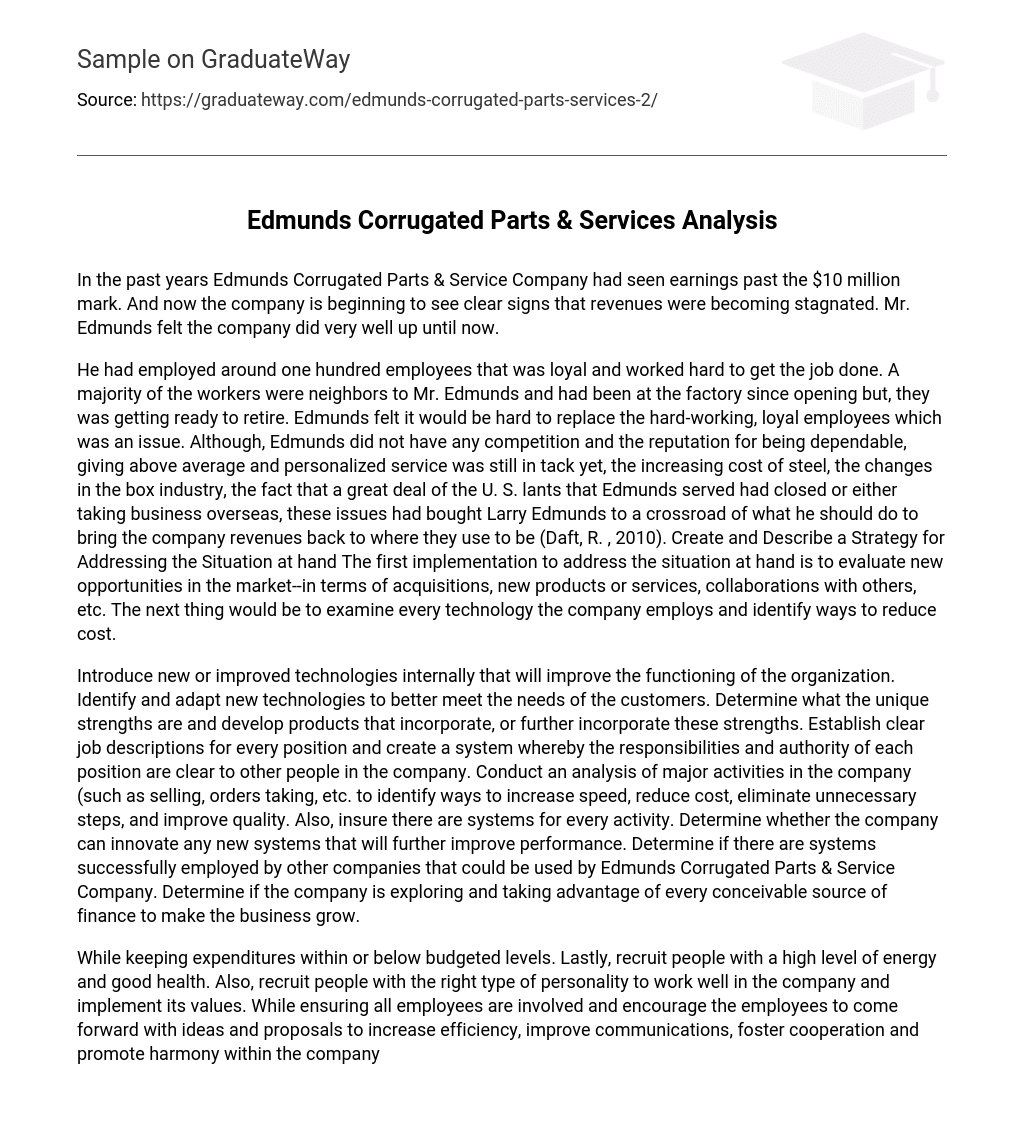In recent years, Edmunds Corrugated Parts & Service Company has achieved earnings surpassing $10 million. However, the company is now witnessing indications of stagnated revenues. Mr. Edmunds acknowledges the success of the company thus far.
Larry Edmunds faced a challenge as most of his approximately one hundred employees, who were loyal and diligent, were nearing retirement age. Finding replacements with the same level of dedication would be difficult. Despite having no competition and a reputation for reliable service, the company’s revenues had declined due to rising steel costs, changes in the box industry, and the closure or relocation of many U.S. plants they served. Larry was at a crossroads on how to restore profitability (Daft, R., 2010).
To address this situation, a strategy could be developed:
- Evaluate potential new opportunities in the market such as acquisitions, introducing new products or services, and forming collaborations with other companies.
- Examine and assess every technology used by the company to find ways to reduce costs and improve efficiency.
Internal introduction or improvement of technologies to enhance organizational functioning. Identify and adapt new technologies to better meet customer needs. Incorporate unique strengths into product development. Establish clear job descriptions and a system for transparent responsibilities and authority. Analyze major activities to increase speed, reduce cost, eliminate unnecessary steps, and improve quality. Implement systems for all activities. Explore innovative systems for improved performance. Take advantage of successful systems from other companies. Ensure the company explores all finance sources for business growth.
While maintaining expenditures within or below budgeted levels, it is also crucial to hire individuals who possess a high level of energy and good health. Additionally, ensuring that these individuals possess the right type of personality to effectively work within the company and implement its values is equally important. Furthermore, it is essential to involve all employees and encourage them to present their ideas and proposals for enhancing efficiency, improving communication, fostering cooperation, and promoting harmony within the company, as well as with its customers and vendors (O’Connell, B. 2004).
Assessing which element in the strategy mentioned above would be the most challenging to implement, it can be inferred that the recruitment of individuals with the appropriate personality to collaborate effectively with the company and Mr. Edmunds would be the most difficult. This difficulty is based on Larry’s statement in Daft, R., 2010, where he acknowledged that replacing skilled workers would be challenging due to his previous experience. Moreover, Larry’s familiarity with most of the workers as they were neighbors adds another layer of complexity to this recruitment process.
Due to the likelihood of the town’s educated and talented youth seeking employment elsewhere, it is necessary for the company to develop a strategy that would encourage them to stay. This would not only benefit Mr. Edmunds by hiring local individuals but also make him feel more at ease with new hires (Daft, R., 2010).
In order to reduce potential crises before they occur, Edmunds could implement several strategies in the future. One approach is to develop a mission statement that accurately reflects the company’s mission. This written document, created by management and based on input from both managers and nonmanagers, defines and explains the organization’s purpose. Having a clear mission statement is crucial as it increases the likelihood of a successful company.
Another strategy Edmunds could adopt is conducting a regular Strengths, Weaknesses, Opportunities, and Threats (SWOT) analysis. This strategic development tool matches internal strengths and weaknesses with external opportunities and threats. By thoroughly reviewing these factors, managers can identify beneficial strategies for ensuring organizational success.
Additionally, Edmunds could utilize a critical question analysis as a third strategy. This analysis involves asking four fundamental questions. The first question focuses on understanding the purposes and objectives of the organization.The purpose of this question is to provide managers with an understanding of the company’s future direction. Certo, S. (2006) states that answering this question during the strategy formulation process helps managers remember this important point and reduce inconsistencies between the organization’s purpose, objectives, and strategies. The second question addresses the current direction of the organization, allowing managers to assess if the company is achieving its goals and if the stage of development is satisfactory. While the first question focuses on where the company should be heading, the second question emphasizes the company’s actual trajectory. Question number three examines the environment in which the company currently operates.
Certo, S. (2006) highlights the importance of both internal and external environments in this analysis. The final question in this critical analysis is how to improve organizational objectives in the future. According to Certo, S. (2006), the answer to this question determines the organization’s strategy. Question number four should be answered after managers have carefully considered the answers to the first three questions.
According to Certo, S. (2006), managers need a clear understanding of the organization’s goals, direction, and environment in order to develop a suitable organizational strategy. This is supported by references to Certo, S. C. (2006) and Daft, R. (2010). In addition, O’Connell, B. (2004) discusses the changing times and their impact on business, as cited in the Baylor Business Review (1), retrieved from http://elibrary.bigchalk.com.





